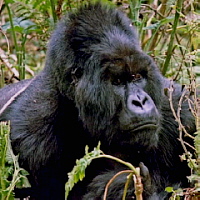The Primate Page |
Physical DescriptionMountain Gorillas are one of the largest living primates (only Grauer’s Gorillas are larger). Upright, the average adult male reaches 1.73 m (5 ft 8 in) in height, has an arm span of 2.29 m (7 ft 6 in) and weighs 155 kg (343 lb) (Knight 2003). Mountain Gorillas have black skin, and face, fingers, palms, and the bottoms of their feet are hairless. The rest of their body is covered with thick, black hair. The trunk is relatively short and the pelvis is wide (Fleagle, 1988). They have broad hands and feet, with opposable thumbs and big toes, enabling them to grasp objects with their feet as well as their hands. The shape of each individual’s nose is unique. Researchers use photographs and illustrations of noseprints for identification. Mountain Gorillas are highly sexually dimorphic, with males usually weighing twice as much as females. When males reach sexual maturity, a saddle of gray or silver-colored hair develops on their backs. These adult males are called silverbacks. The hair on their backs is shorter than on most other body parts, and especially long on their arms. Adult males have more pronounced bony crests on the top (sagittal) and back (nuchal) of their skulls, giving their heads a conical shape (SNZP). These crests anchor the muscles used to operate their large jaws and teeth. They are much less pronounced in adult females. Males also have apocrine glands in their armpits. When males are under stress, these glands emit a strong odor (BRD). Eastern Gorillas (including the Mountain Gorillas) generally have smaller heads, shorter arms, and narrower noses than the Western Gorillas. They have darker black hair than the Western, whose coat may have shades of gray or brown. The Mountain Gorillas have adapted to life at higher altitudes and with cooler temperatures than other gorillas. Less fruit is available in this climate; plant parts make up the vast majority of foods consumed. Thus, they have longer hair to keep them warm, and their molar teeth have highly developed crests to process fibrous plants (Fleagle, 1988). Mountain Gorillas are also best adapted to life on the ground, and their feet most resemble those of humans, with the big toe closer to the other four and connected by webbing (Fleagle, 1988). LocomotionMountain Gorillas are primarily quadrupedal and they are among the most terrestrial of the primates. Males may run bipedally for up to 6 m (20 ft) during chest-beating displays, but bipedalism is rare at other times (Knight 2003). Like all great apes, their arms are shorter than their legs. They move by knuckle-walking, supporting their weight on the backs of their curved fingers rather than their palms (Fleagle, 1988). Adults rarely climb trees; juvenilles will climb into the branches during play. Females will climb for fruit, as will a silverback if the branches can support his weight. They rarely jump from tree to tree or hang below the branches, climbing quadrupedally the vast majority of the time. |

|
| credits « some rights reserved » about | last updated: 15 March 2005 |